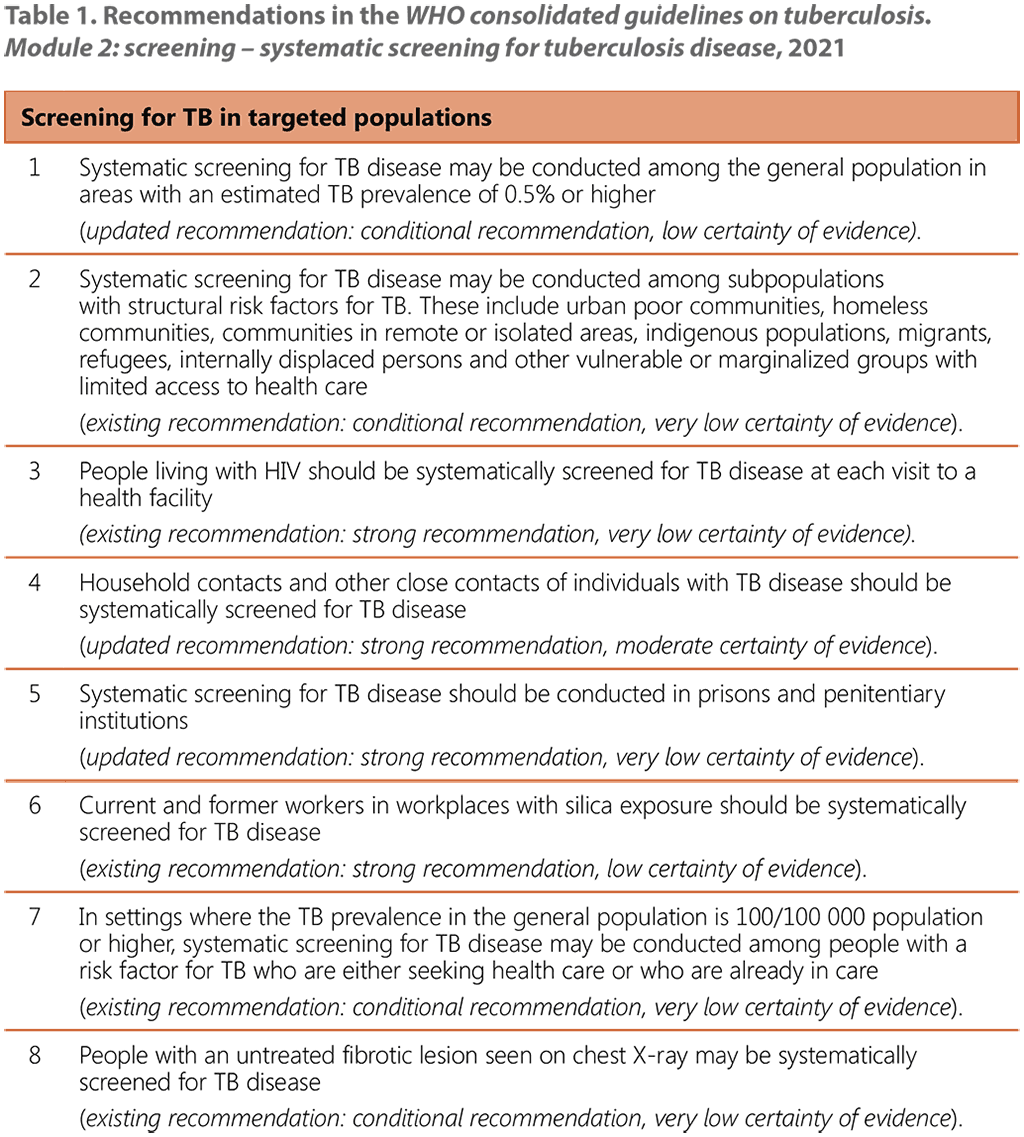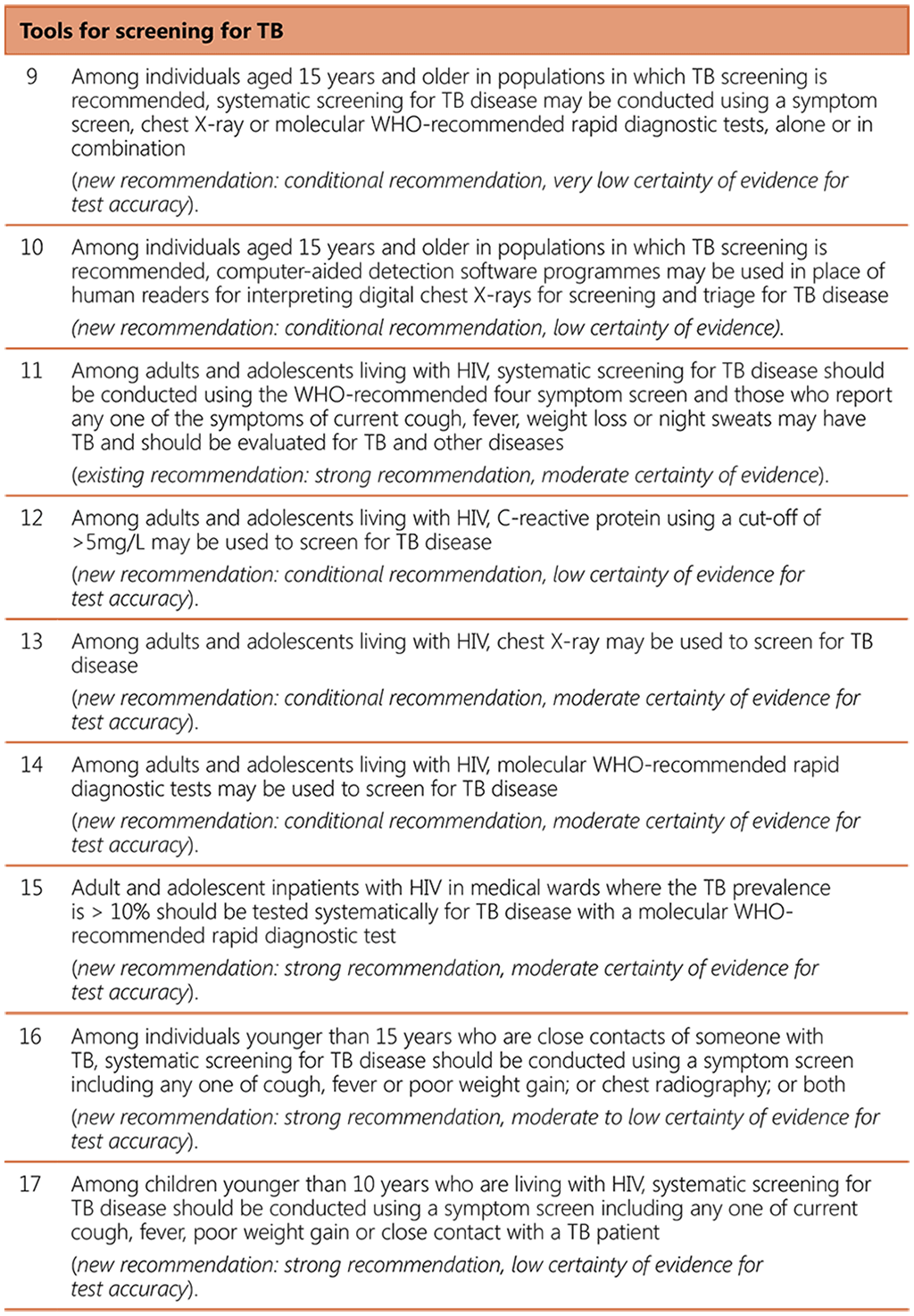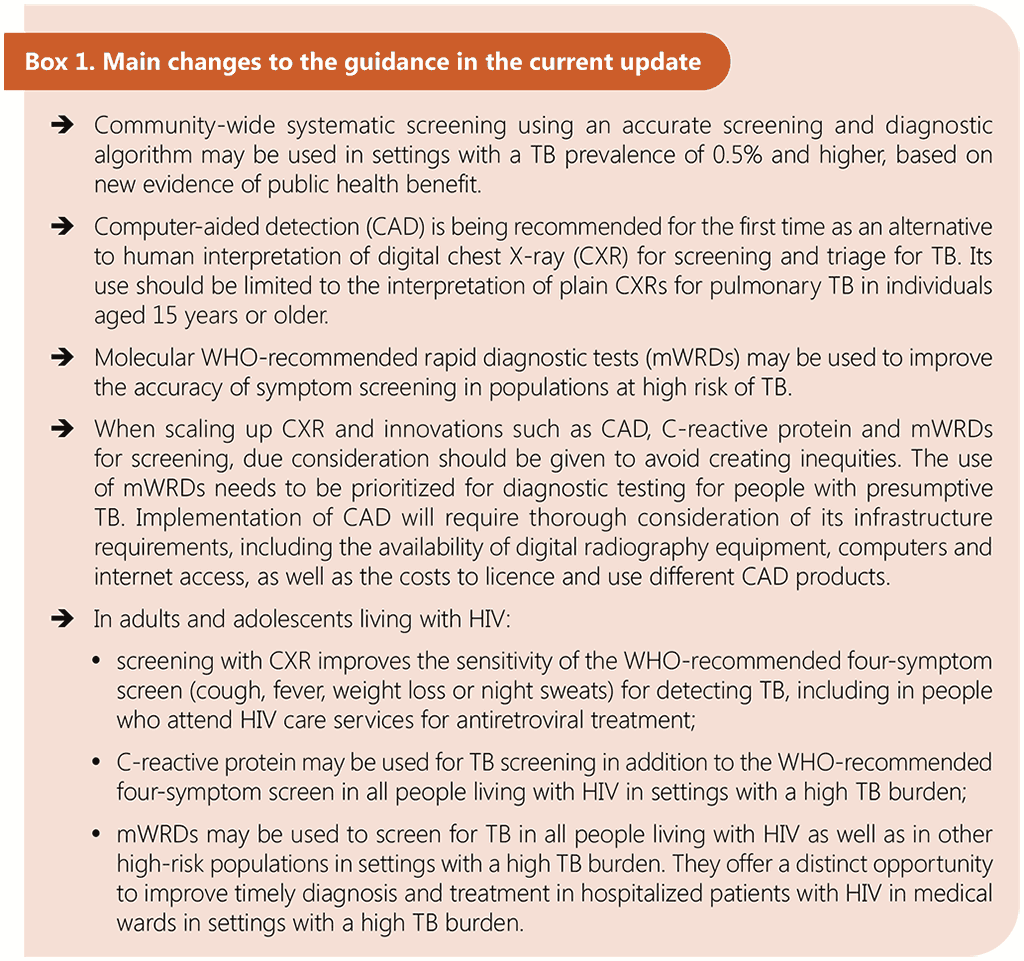Book traversal links for Executive summary
Tuberculosis (TB) is a leading cause of death from a single infectious agent, despite being largely curable and preventable. In 2019 an estimated 2.9 million of the 10 million people who fell ill with TB were not diagnosed or reported to the World Health Organization (WHO). The Political Declaration adopted by the United Nations General Assembly in September 2018 at the High-Level Meeting on the Fight Against Tuberculosis commits to, among other goals, diagnosing and treating 40 million people with TB by 2022. In order to achieve this ambitious target, there is an urgent need to deploy strategies to improve the diagnosis and initiation of care for people with TB. One of these strategies is systematic screening for TB disease, which is included in the End TB Strategy as a central component of its first pillar aimed at ensuring early diagnosis for all with TB.
To facilitate the implementation of TB screening at the country level, WHO published guidelines on Systematic screening for active tuberculosis: principles and recommendations in 2013. Since then, there have been important new studies evaluating the impact of screening interventions on both individual-level and community-level outcomes related to TB, as well as new research evaluating innovative tools for screening for TB – including the use of computer-aided detection of TB on digital radiographs, C-reactive protein (CRP) is an indicator of inflammation that can be measured using point-of-care tests for TB – among important populations at high risk for TB disease.
In view of these new developments and due to requests by countries for more guidance, WHO convened a Guideline Development Group (GDG) in 2020 to examine the evidence and update the 2013 guidelines. The GDG met in virtual sessions between June and October 2020 and proposed several new and updated recommendations related to TB screening. WHO gratefully acknowledges the work of the GDG members, the evidence reviewers, representatives of national TB and HIV programmes, WHO colleagues, technical and funding partners, civil society representatives, patients and all others who contributed to the data used to inform this guideline update.
The evidence reviewed to address the guideline questions was derived from several trials and other studies, programmatic data, surveys and modelling work. The certainty of the evidence and the strength of the recommendations were assessed using the GRADE (Grading of Recommendations Assessment, Development and Evaluation) method. Decisions about the strength of a recommendation and the evidence depend on the level of confidence in the estimates, as well as on other critical considerations, such as acceptability, feasibility, resource use and impact on health equity.
The use of chest radiography (chest X-ray, or CXR) as a screening tool for detecting TB disease in several populations was reviewed, including in the general public, people living with HIV, people younger than 15 years who are contacts of TB patients and other high-risk groups. Across all populations considered, CXR was found to be a sensitive screening tool that, while lacking sufficient specificity to confirm a TB diagnosis, has an important role in the early detection of TB in children and adults who are at higher risk of TB, as well as the potential to reduce the population burden of TB disease when combined with early treatment.
In recent years computer-aided detection (CAD) software packages have been developed and introduced to automate the interpretation of digital CXR images and produce a numerical score indicating the likelihood of TB. Three independent evaluations of CAD were reviewed to develop recommendations for both screening and triage for TB. The diagnostic accuracy and the overall performance of CAD software were similar to the interpretation of digital CXR by a human reader, in both the screening and triage contexts. Evaluations showed substantial variation in diagnostic accuracy across different contexts, implying that the use of CAD will require calibration for the purpose and setting in which it will be implemented.
C-reactive protein (CRP) is an indicator of inflammation that can be measured using point-of-care tests performed on capillary blood collected via finger prick. The accuracy of CRP to detect bacteriologically confirmed TB in people living with HIV was assessed with a meta-analysis of individual patient data of people screened in high- and medium-burden settings. CRP was found to have similar sensitivity and higher or similar specificity to symptom screening in all subpopulations tested. CRP offers a clinically significant improvement in accuracy over the WHO-recommended four-symptom screen among ambulant people living with HIV who are newly in care and not yet on antiretroviral treatment, a subpopulation for whom the accuracy of the four-symptom screen is low.
Molecular WHO-recommended rapid diagnostic tests for TB (mWRDs; eg Xpert MTB/RIF) were reviewed for use as TB screening tools among different populations at high risk of TB. Evidence shows improved accuracy and effectiveness in people living with HIV and in other high-risk populations. The evidence is strongest for hospitalized patients with HIV in settings with a high burden of TB, given the limited value of symptom screening and the grave consequences of missing the opportunity to initiate TB treatment promptly in this patient group.
Based on these updates, a set of 17 new and revised recommendations for screening for TB disease have been developed (Table 1). The main changes from the previous WHO guidance are summarized in Box 1. The new guidelines replace all previous WHO guidance on TB screening. The recommendations are accompanied by updated operational guidance, the WHO operational handbook on tuberculosis. Module 2: screening – systematic screening for tuberculosis disease, that includes further details on target populations and tools to use for systematic screening, including revised algorithms and modelled estimates of their performance.



TB: tuberculosis.
 Feedback
Feedback